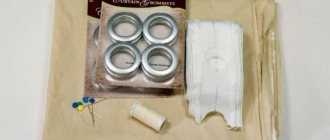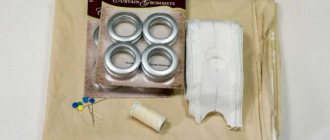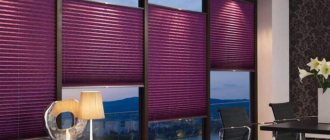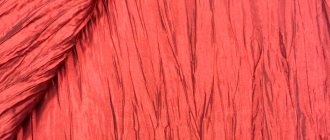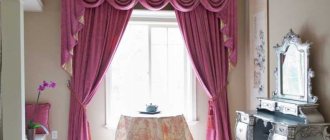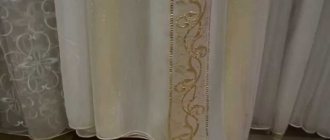Textiles can greatly enhance the style of any room. Curtains have become an integral part of the interior.
They can be dense, heavy, draw attention to themselves, or they can create the effect of lightness and weightlessness. Draping curtains turns a simple fabric into an unusual product.
A purchased ready-made version of the curtain may turn out to be completely inappropriate in the existing room.
In this case, draping curtains with your own hands can correct the situation. You will need very little for this:
- curtain fabric;
- threads, curtain tape;
- decorative elements (cords, tassels, beads).
Advantages of curtain tape
Previously, curtains were attached to the cornice in different ways: loops were sewn on by hand, metal clips were used, which could damage the material, and rings were used.
With the advent of curtain tape, hanging a curtain is very easy. In addition, using tape you can create different options for draping curtains.
With the advent of a special braid, it became possible to change the height of the curtain without much effort. Thanks to several rows of loops, it is enough to fasten the hooks on the row above or below.
The canvas holds its shape better and remains in its original form longer. After washing, it will not be difficult to restore the curves of the curtains on the cornice. With the right choice of color and method of draping the canvas, you can decorate the window opening of any interior.
Using the tape is very simple. It is sewn at a small (0.2 - 0.5 cm) distance from the top edge from the wrong side. Draperies are formed using cords, pulling the fabric from the edge to the center.
The main condition is a sufficient margin of curtain width. For all cornice design options, you need at least two widths of fabric. For more magnificent and ceremonial options, a build factor of 2.5-3 is often required.
Decor options
Drapery consists of different fold options. They can be laid to one side at equal intervals (this is one of the simplest options).
If you want to create something original, you need to use your imagination and play with the canvas. The folds can be laid towards each other (counter), or vice versa, using paired bends to form flat bows.
The thickness of the tape and the number of cords for broaches depend on the method of decoration and the density of the fabric. Some options are formed directly on the cornice after the curtain is already hanging. This creates loop-shaped folds. The main thing is to maintain the same distance between them.
Beautiful drapery of curtains is obtained if you use a special thin cord to form folds. This option is called Flemish. You can lay folds in the form of geometric shapes. For example, buffalo ones resemble diamonds.
Drapery of arches
An arched opening can be at a window, door or interior opening. Depending on this, the shape of the drapery is chosen.
There are several drapery methods for window arches:
- on a straight cornice above an arched opening - in rooms of low height;
- on a straight cornice under an arched bend - to emphasize its beauty;
- on a flexible cornice according to the shape of the bend, so as not to add width to the space;
- on separate hooks along the bend - to create a more airy structure.
The choice of method depends on the size of the room, lighting, number of windows, and interior style.
If the windows face the courtyard, designers prefer to emphasize their beauty, leaving them without textile decoration at all.
For arched windows, you can even choose roller blinds, Roman blinds, pleated blinds, curtains with tiebacks, or choose a cross arrangement of canvases. Kisey looks especially impressive here.
An interior arch can also be draped with textiles instead of installing a door. In this case, they use the same rule as when decorating ordinary doorways: textiles should repeat the style and design of the windows in the room where it leads. If the windows in the room have tiebacks, the same should be in the arched doorway.
Curtain for the attic window
Consider the option of sewing curtains for a non-standard dormer window yourself. The different architecture of the second floor suggests the presence of non-standard windows. They may be shaped like an irregular triangle or beveled at a certain angle. In fact, it is not very difficult as it may seem at first.
First, take the dimensions of the window using a measuring ruler. The straight side of the curtain is processed and sewn according to the usual, standard pattern. Two measurements are taken along the beveled side: the top and bottom points.
A drapery is made in the middle of the beveled part of the window. First, treat the sides of the curtain, and then refine the bottom and top.
Be sure to set aside a couple of centimeters for the seam allowance and sew on the braid. Even with unconvincing sewing skills, you can realize your desire and get the expected result.
The role of drapery in the interior
Draping curtains is a concept that implies all sorts of ways to decorate window curtains with folds in order to give them an elegant, luxurious appearance.
There are two ways to drape curtains:
- Form fixed longitudinal (or transverse, as is the case with horizontally folding products - Roman and Austrian curtains) folds on the curtain panels, which are laid at the stage of sewing the curtains;
- Create folds on curtains using unusual options for their arrangement on windows, in which the fabric does not just fall down freely, but is collected into fancy shapes using tiebacks or fastenings with staples. For this purpose, special accessories for curtains are often used - rings and magnets.
Both drapery options are used to achieve one final result - to make the design of the window opening expressive and solemn. This decoration allows you to fully unleash the potential of noble fabrics such as jacquard, silk, and satin.
Often drapery becomes the decisive factor that determines the visual differences between some models of window curtains and others. For example, Austrian and Roman curtains are, in fact, rectangular pieces of fabric similar to each other, which differ only in that the Roman products have laconic, even horizontal folds, while in the Austrian version the entire area of the curtain is covered with convex folds.
In addition to panels, pelmets are also subject to drapery, which is decorated with arched or cone-shaped sags (swags), molds, ties or frills.
Ways to beautifully drape curtains
Professional designers masterfully form folds by hand. The fabric is pre-sewn, eliminating the possibility of damage to the structure of the assemblies over time. The labor-intensive method of manually draping curtains pays off with reliability and long service life.
One curtain can be draped in several ways at different times, and it will look different, creating the illusion that the textiles have been replaced. Ornate flowing folds of translucent tulle framed by jacquard, silk or tapestry evoke a feeling of admiration.
We present just some types of curtain drapery:
Curtain tape is a good assistant in draping curtains. It is sewn from the inside out and can be made of mesh or textile. By pulling it, you can create beautiful vertical folds. The curtains are fixed to the curtain rod with hooks. The width of the canvas must be several times longer than the cornice. Folds are formed at selected intervals.
In order for the curtain display to give the room an original chic and create a harmonious ensemble, you should take into account the depth of the folds and buy the amount of fabric according to the multiplicity of the assembly. To achieve the effect of rich drapery, the length of the curtain should be 3 times the length of the assembled braid.
The width of the tape can be different, which will satisfy any wishes and preferences. With the help of braid, both draped tulle for a small kitchen and heavy curtains in the living room stand out against the general background.
To create drapery, you can use tiebacks, classically collecting curtains from the sides at the level of the window sill or below, symmetrically or asymmetrically. A winning interior composition is created, the perspective of the view from the window opens, and the regulation of penetrating natural light is formed.
Even simple plain curtains will look solemn if you complement them with decorative tiebacks. A unique and cost-free method of draping can be achieved by hanging the curtains in parallel, without moving them apart, moving them apart, and securing them with tiebacks.
We do it ourselves
Short draperies have an undeniable advantage - they are easy to manufacture, so you can make them yourself. Detailed instructions for any model, patterns can be found in the interior, and the necessary tips and recommendations are below:
- Check out the latest short curtain designs for 2021;
- Give preference to simple models without frills or ruffles;
- It is better to choose cotton, linen, organza or polyester in pastel shades;
- For French models, you should purchase 2-2.5 more fabric from the desired length;
- Leave at least 6 cm on each side for hems and seams;
- Lambrequins are made from the same fabric, and ties and decorative elements are made from contrasting fabric.



